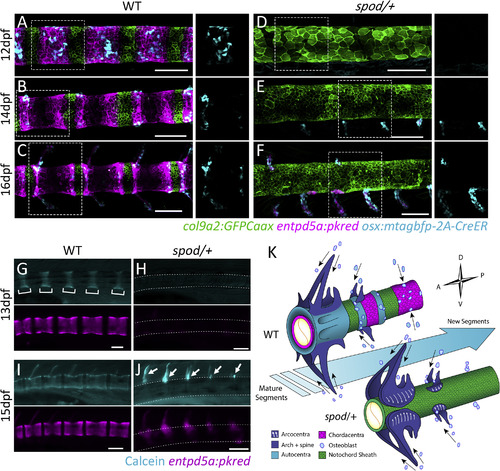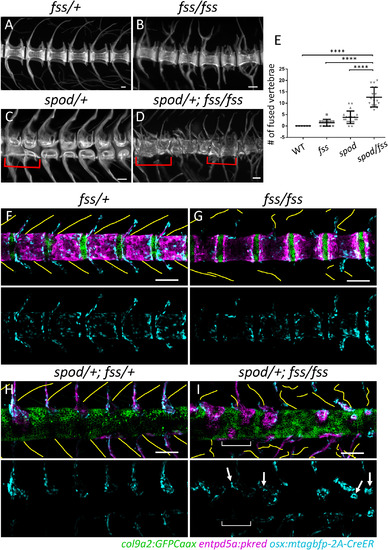- Title
-
Notochordal Signals Establish Phylogenetic Identity of the Teleost Spine
- Authors
- Peskin, B., Henke, K., Cumplido, N., Treaster, S., Harris, M.P., Bagnat, M., Arratia, G.
- Source
- Full text @ Curr. Biol.
|
The spondo Mutant Impairs Axial Patterning and Leads to the Formation of Hemicentra (A and A′) spondo mutant zebrafish are viable. 4 dpf larval morphology of wild-type and cmnspod heterozygous larvae. Mutants show normal patterning of larval structures, however, are shorter in length. (B and B′) cmnspod/+ mutants are viable and exhibit short stature as adults. (C and C′) Tomographic reconstruction of vertebrae of wild-type (C) and spondo heterozygous C′) adult fish showing formation of hemicentra and periodic diplospondyly (arrow). Homozygous fish show an increase in phenotype (Figure S1). (D) Lateral and dorsal views of cmnspod/+ alizarin red stained skeletal preps. Hemicentra are present along the body axis. Arrows indicate vertebral clefts. (D′) The frequency of vertebral clefts along the body axis was quantified. Dorsal clefts were found bimodally in the rostral and caudal regions of the vertebral column, while lateral clefts were most prominent in the caudal region and associated with non-rib-bearing vertebrae. (E) Early specification of notochordal patterning is disrupted in spondo mutants. In wild-type fish, col9a2:GFPCaax expression is restricted to the prospective intervertebral discs (IVD), while entpd5a expression is activated in the mineralizing domains (future chordacentra) of the notochord sheath (bottom). (E′) Specification of the IVD and mineralizing domains is absent in spondo mutants, while the expression domain of col9a2 is expanded. Overlay of entpd5a and col9a2 transgenes shows lack of meristic patterning of chordacentra in spondo mutants. (F) entpd5a expression in wild-type juvenile fish. (F′) Heterozygous mutant showing altered patterning of centra mineralization; arrow points to a developing diplospondylous vertebrae. EXPRESSION / LABELING:
|
|
Patterning of the Spine and the Evolution of the Teleost Vertebral Centrum Reconstructing the changes in spine patterning and morphology during the evolution of teleosts. (A) The earliest members of stem teleosts lacked a vertebral centrum, and instead retained a functional notochord supporting the arches and spines. This is illustrated by the stem pachycormiform †Orthocormus roeperi; see also (E) state “0.” (B) †Pholidoctenus serianus illustrates a more derived condition present among some pholidophoriforms, with diplospondylous vertebral centra formed by hemi-chordacentra; see also (E) state “1.” (C) †Leptolepis coryphanoides illustrates a major transformation within the spine of stem teleosts, characterized by the appearance of a thin hourglass-shaped autocentrum surrounding a ring-like chordacentrum; see also (E) state “2.” (D) Subsequently, the autocentrum incorporated a thickened lateral wall, and a series of ornaments, such as crest, grooves and pits, as illustrated by the oldest fossil member of the teleost crown group †Anaethalion sp., a condition retained in, and defining all living teleosts; see also (E) state “3.” (E) Reconstructed scenario of the evolution of the teleosteomorph spine—from a basal functional notochord supporting the arches and spines—leading to a chordacentrum plus autocentrum in recent teleosts, or to a chordacentrum plus arcocentrum among extinct aspidorhynchiforms. (F) Consensus-phylogenetic hypothesis of the total-group teleosts or teleosteomorphs mapped on the geological timescale. The phylogenetic hypothesis was adapted from Arratia et al. (2019). As outgroup taxa, the analysis included five members of Holostei based on a total of 198 morphological characters. |
|
spondo Is a Dominant, Gain-of-Function Mutation in cmn (A) The spondo mutant phenotype is due to an early, nonsynonymous mutation in the calymmin gene (M10R). pd1211 mutation is a 2 bp deletion upstream of spondo that results in an early stop codon. (B) Expression of cmn during early zebrafish development is confined to the notochord (Figure S3). (C) Cross-section of 12 dpf larvae depicting the restriction of cmn expression to the notochord sheath cells. The spondo mutation causes disruption of the notochordal sheath (Figure S3). (D and D′) At later developmental stages, cmn expression becomes segmented and downregulated in cells that form the chordacentra. The expression is most highly upregulated in the col9a2 domain and in cells that are actively differentiating into mineralizing cells and express both col9a2 and entpd5a (arrows). (E) cmn is a highly derived paralog of an elastin-like extracellular protein. The locus containing cmn is duplicated in zebrafish, retaining synteny with neighboring genes. The gene altered in spondo (asterisk) is highly differentiated from its other paralog (“a”) as well as orthologs found in sarcopterygian lineages and is generally conserved among teleost fishes (Figure S2). (F and G) Overexpression of cmn containing the spondo mutation inhibits sheath cell differentiation into mineralizing cells. DNA constructs containing either QUAS:GFPCaax or QUAS:spod-p2A-EGFP sequences were mosaically overexpressed in a col9a2:QF2 transgenic line. Gaps in entpd5a:pkred expression within mineralizing domains were quantified (arrows). In control conditions, 14.1% of GFP+ sheath cells did not express entpd5a. In the experimental group of fish overexpressing the spondo mutation, 42.2% of GFP+ sheath cells were entpd5a negative. Two tailed p value = 0.0006. Overexpression of wild-type cmn does not have any effect (Figure S4). (H–K′) Reversion of spondo phenotype by creation of disruptive alleles in cis and trans to cmnspondo. Pooled guides targeting cmn injected into wild-type or cmnspod/+ embryos lead to mosaic deletions within the cmn locus. Targeting deletions to cmn reverted the spondo phenotype and partially restored notochord segmentation in 11/11 cmnspod/+ fish analyzed. Phenotype of injected fish closely resembles individuals containing the loss of function allele, pd1211 (Figure S5). See also Table S1. EXPRESSION / LABELING:
|
|
The spod Mutation Results in a Developmental Shift in Centra Patterning and Enhanced Osteoblast Contribution to Arcualia/Spines (A) Following notochord segmentation in wild-type zebrafish, sclerotomal osteoblasts are recruited to the mineralizing domains of the notochord sheath and overlay the chordacentra. (B and C) Osteoblasts anchor dorsally and ventrally on each mineralizing domain (B) and establish growth sites for the neural and hemal arches (C). (D) Notochord sheath cells are irregular and do not differentiate into mineralizing cells of the chordacentra in spondo mutants. (E) Osteoblasts prematurely migrate to focal points on the notochord sheath that will form the arches. (F) Osteoblasts never migrate to centra domains and only contribute to neural and hemal arcualia. Insets represent regions outlined by the dotted lines in which the blue channel (osteoblasts) has been isolated. (G–J) Live calcein staining of the same wild-type and spondo mutant fish imaged over time. (G and I) Chordacentra mineralize from the center of the entpd5a positive domain outward in wild-type fish. (I) Arches are ossified after the centra. (H and J) spondo mutants fail to form mineralized chordacentra. Ossification only occurs in the arches to which osteoblasts have been recruited. (K) Hypothesis of osteoblast migration patterns and their relationship to notochord segmentation. Arrows represent migratory paths. In wild-type fish, notochord segmentation guides osteoblast migratory patterns to form the final vertebral body structure. Subsequently, osteoblasts rely on cues from somite segmentation and migrate along segment boundaries to form vertebral arches. In spondo mutants, where notochord segmentation does not occur, osteoblasts fail to migrate to form centra structures. Osteoblasts solely migrate along somite segment boundaries to form vertebral arches. Hemicentra form as osteoblasts secrete osteoid matrix in regions of arch attachment and spill over to form partial centra (arcocentra extensions), closely resembling the basal condition of all Osteichthyes including early sarcopterygians lineages that lead to tetrapods. EXPRESSION / LABELING:
PHENOTYPE:
|
|
Sensitization of cmnspod Mutants to Tetrapod Segmentation Programs (A–D) Alizarin red stained skeletal preparations at 6 wpf. (A) Wild-type skeletal preps demonstrate meristically patterned autocentra and arches. (B) tbx6fss/fss mutants display irregular arch morphology and patterning, while centra remain regularly segmented. (C) cmnspod/+ mutants have the opposite phenotype wherein arch patterning is normal and the centra contain large vertebral clefts. (D) Double mutants in which both notochord and somite segmentation have been disrupted are not simply a combination of the two aforementioned phenotypes. In contrast, double mutants form highly irregular vertebral structures with very little discernable patterning. Red brackets indicate vertebral fusion events. (E) The number of fused vertebrae in each condition was quantified along the body axis using alizarin red stained skeletal preparations. The number of fused vertebrae in double mutants was significantly greater than in all other conditions. Wild-type n = 6; tbx6fss/fss n = 12; cmnspod/+ n = 20; cmnspod/+;tbx6fss/fss n = 17 fish. Error bars indicate standard deviation. **** indicates p value less than 0.0001. (F–I) Alteration In notochordal patterning demonstrating alteration in early sensitivity of spondo mutants to tbx6 mutations; yellow lines indicate traced somite segment boundaries; blue channel (osteoblasts) has been isolated below each composite image. (F and H) In wild-type and spondo fish, regions of somite boundaries correlate with articulated pattern of vertebral arches. (G) The tbx6fss/fss mutant has impaired somite segmentation where partial segment boundaries form without any metameric pattern. Lack of paraxial mesoderm patterning alters the morphology and arrangement of developing vertebral arches while notochord segmentation is largely unaffected. There is some variability in size of the centra domains (not quantified). (I) In spondo;tbx6 double mutants, both notochord and somite segmentation are impaired. Osteoblasts are found nearby partial boundaries. The bracket indicates a region devoid of segment boundaries as well as osteoblasts. Arrows mark osteoblasts in close proximity to partial somite boundaries that have begun to spill over to form hemicentra structures. EXPRESSION / LABELING:
PHENOTYPE:
|





